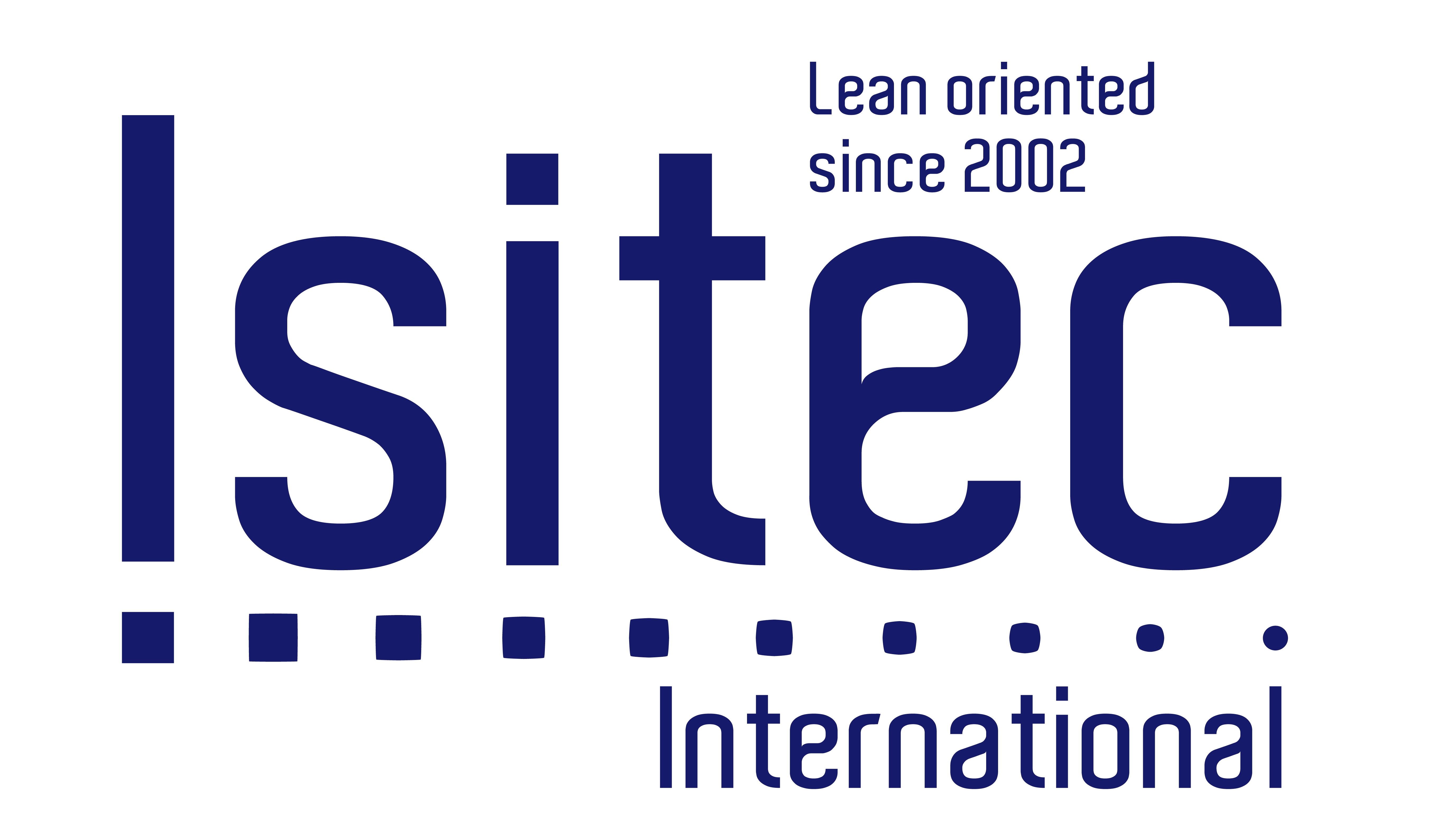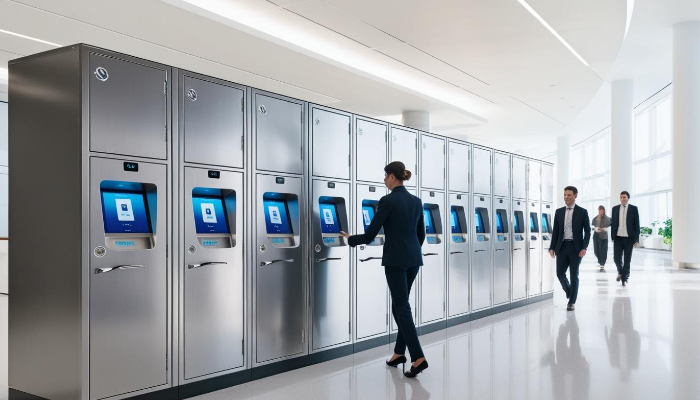In the current context of changing working methods, general services make a significant contribution to the organization of spaces and flows within companies. The growing adoption of hybrid working since 2020 has forced these departments to rethink their processes and infrastructures. Connected lockers, also known as smart lockers, represent a technical solution adopted by many general departments to meet these new organizational challenges.
This equipment, recognizable by its digital interface and modular compartment system, was initially deployed to simplify parcel reception. Over time, their use has diversified to meet different internal logistics needs. Let’s take a look at five concrete applications seen in contemporary business environments.
1. Reception and distribution of internal parcels
This application is the main use of connected lockers in companies. Every day, mail and logistics departments receive parcels destined for employees, be they business equipment or personal purchases delivered to the workplace. In a large company, this volume can represent dozens or even hundreds of parcels a day.
The increase in teleworking and hybrid organizations makes this task even more complex. The mailroom can no longer predict with certainty whether recipients will be present on site, which often leads to prolonged temporary storage and repeated communications to organize parcel delivery.
The operating process with lockers generally goes like this: after receiving a parcel, the mail department registers it in a management system, places it in an appropriately sized locker, and the associated software automatically generates a notification for the recipient. This notification, sent by e-mail or via an internal communication tool such as Microsoft Teams, contains a unique access code or QR code. The employee can then go to the locker at any time, identify himself and collect his parcel without human intervention.
This method offers several practical advantages:
- Mailroom staff can process parcels in batches at defined times of the day, rather than being interrupted continuously.
- The system adapts naturally to employees’ variable working hours and teleworking days
- A digital history of each transaction is kept, enabling delivery issues to be resolved quickly.
- Employees gain greater autonomy and can collect their parcels outside mailroom opening hours.
2. Exchange of documents and objects between collaborators
In large, flex-office companies, where workstations are not individually assigned, physically locating a colleague can be a daily challenge. E-mail and virtual collaboration tools do not allow the exchange of physical objects or confidential documents that cannot be digitized.
Connected lockers offer a solution to this logistical problem. The typical process is as follows: an employee places a document or object in an available locker via the locker interface, selects the recipient from the integrated company directory, and confirms the deposit. The system then generates a notification to the recipient with the information needed to access the locker.
This mechanism is particularly useful in a number of practical situations:
- Transmission of original contractual documents requiring handwritten signatures
- Sharing USB sticks containing large or sensitive data
- Handover of samples, prototypes or other physical objects between departments
- Transmission of visitor or temporary access badges
This function facilitates physical exchanges in an environment where the simultaneous presence of employees is no longer guaranteed, while maintaining an appropriate level of traceability.
3. Material distribution by support services
Corporate IT departments regularly handle the distribution and retrieval of technical equipment. Whether it’s new laptops, business phones, peripherals or spare parts, these equipment movements represent a significant logistical burden.
The traditional process, based on individual meetings between technicians and end-users, has a number of drawbacks: limited time slots, mutual delays, and the mobilization of qualified technical staff for essentially logistical tasks.
Using connected lockers, the IT department can prepare equipment in advance (software installation, configuration, testing), place it in a locker, and program automatic notification for the recipient. Advanced systems even allow integration with IT asset management tools, ensuring automatic updating of equipment assignments.
This method offers several organizational advantages:
- Secure equipment delivery with electronic validation of the recipient’s identity
- Complete traceability of operations, with precise time and date stamping
- Optimization of technicians’ time, enabling them to concentrate on higher value-added tasks
- The ability to replace equipment outside standard office hours
Other support departments, such as human resources, also use this infrastructure for the secure transmission of confidential documents (contracts, specific pay slips) or the delivery of complete induction kits for new employees.
4. Services de conciergerie d’entreprise
Connected lockers are an integral part of the concierge services offered by some companies as part of their quality of working life policy. This service is particularly appreciated in densely populated urban areas, where home delivery can be problematic.
In addition to parcels, these systems can be adapted to a range of additional services:
- Dry-cleaning service with garment drop-off and pick-up
- Delivery of food baskets or prepared meals
- Key collection and deposit for home services
- Distribution of works council products
The system is generally based on prior reservation via a dedicated application, followed by notification when the service or product is available in an assigned locker. This system enables employees to access practical services without leaving their workplace, and without disrupting their working day.
These services, which are particularly useful at sites with extended opening hours or in business zones with limited accessibility, help to improve working conditions, without requiring continuous human presence for their operation.
5. Temporary personal lockers
The spread of dynamic workspaces (shared offices, specific activity zones) has reduced the possibilities for permanent personal storage. Yet employees regularly need secure spaces in which to temporarily store their belongings.
Connected lockers meet this need by functioning as temporary personal lockers, accessible via the company badge or a dedicated mobile application. Users identify themselves to the system, which automatically assigns them an available locker for a set period (a few hours or a whole day).
Typical uses include :
- Storage of personal belongings during a meeting in another building
- Secure storage of sports equipment for employees exercising before or after their working day
- Temporary storage of work documents when moving between different sites within the same company
- Conservation of specific equipment used occasionally
This application offers a practical solution that fits perfectly into today’s flexible work environments, where allocated personal space is tending to diminish in favor of more diversified shared spaces.
Conclusion
Connected lockers are a technical tool that is becoming increasingly integrated into contemporary working environments. Their versatility enables them to meet a wide range of organizational needs: internal logistics, staff exchanges, equipment distribution, concierge services and temporary storage.
These systems are part of a wider evolution in workspaces, characterized by greater flexibility in occupancy and increased digitalization of support processes. Although their initial deployment represents an investment, they generally contribute to a rationalization of physical flows within the company.
The technological evolution of this equipment continues, with the integration of biometric functionalities, connection to intelligent building management systems, and adaptation to specific uses such as secure recharging of electronic devices or temperature-controlled storage.

